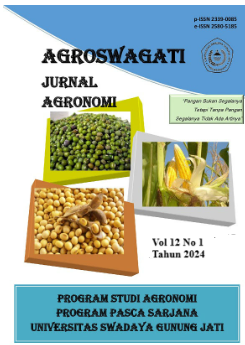Pengaruh Dosis Pupuk Kompos Dan Pupuk NPK Terhadap Pertumbuhan Dan Hasil Tanaman Hanjeli Pulut (Coix lacryma-jobi L.)
DOI:
https://doi.org/10.33603/agroswagati.v12i1.10870Abstract
Hanjeli (Coix lacryma-jobi L.), particularly the pulut type of the mayuen variety, has great potential as an alternative food source in Indonesia. However, its utilization remains limited due to the absence of superior cultivars and the lack of breeding and agronomic research. In fact, its relatively high nutritional content can support food diversification. This study aimed to examine the effect of compost and NPK fertilizer dosages on the growth and yield of hanjeli pulut (C. lacryma-jobi L. var. mayuen). The experiment was arranged in a Randomized Block Design (RBD) with two factors: compost fertilizer dosage (K1 = 5 tons/ha, K2 = 10 tons/ha, K3 = 15 tons/ha) and NPK fertilizer dosage (N1 = 200 kg/ha, N2 = 300 kg/ha, N3 = 400 kg/ha). The results showed a significant interaction between compost and NPK fertilizer treatments on plant height at 13 weeks after planting (WAP). The combination of 15 tons/ha compost and 400 kg/ha NPK produced the best effect on growth and yield, with productivity reaching 3.09 tons/ha under 15 tons/ha compost treatment and 2.79 tons/ha under 400 kg/ha NPK treatment. Moreover, a positive correlation was found between growth components, namely the number of leaves at 13 WAP and the number of tillers at 13 WAP, with yield components such as seed weight per plot. Thus, the application of 15 tons/ha compost and 400 kg/ha NPK fertilizer can significantly improve the growth and productivity of hanjeli pulut (C. lacryma-jobi L. var. mayuen), highlighting its potential as an alternative food crop in Indonesia.
Downloads
Published
Issue
Section
Citation Check
License
Copyright (c) 2025 Mierza Priambodo, Endang Tadjudin Surawinata , Iman Sungkawa

This work is licensed under a Creative Commons Attribution-ShareAlike 4.0 International License.
The Authors submitting a manuscript do so on the understanding that if accepted for publication, copyright of the article shall be assigned to Jurnal AGROSWAGATI, Sekolah Pascasarjana Ilmu Pertanian. Universitas Swadaya Gunung Jati as publisher of the journal. Copyright encompasses rights to reproduce and deliver the article in all form and media, including reprints, photographs, microfilms, and any other similar reproductions, as well as translations.
Jurnal AGROSWAGATI, Universitas Swadaya Gunung Jati and the Editors make every effort to ensure that no wrong or misleading data, opinions or statements be published in the journal. In any way, the contents of the articles and advertisements published in Jurnal AGROSWAGATIare the sole responsibility of their respective authors and advertisers.










